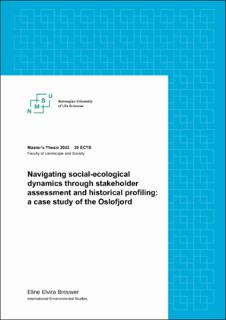| dc.description.abstract | Earlier studies and reports have demonstrated that the Oslofjord has encountered many environmental issues in the last two centuries. This study aims to contribute to understanding the complex social-ecological changes that have occurred in the inner Oslofjord from a resilience thinking perspective. Specifically, I have examined the issues through the perceptions of the Oslofjord’s condition held by both residents and experts, and how they have experienced major social-ecological changes. Moreover, I drew upon a literature review to investigate when major events occurred and what the responses have been. The data were collected through questionnaires for residents and semi-structured interviews for experts.
The residents were asked about their opinions on the state of the Oslofjord, what major social-ecological changes they have observed, their perceptions of the main causes, and their willingness to change their own behavior. The results showed that the residents perceived the current state of the Oslofjord negatively. Most of them have observed social-ecological changes such as the decline in marine life, an increase in alien species, while also increased recreation, and growing interest in the fjord. Pollution, certain fishing practices, and increased infrastructure were viewed as the main causes of the social-ecological changes. Most of the residents expressed a willingness to change their behavior for a better Oslofjord, but are uncertain as to how they can change.
Some experts showed a more positive attitude about the current state of the Oslofjord, while acknowledging that the fjord is still in a poor condition. They also discussed major social-ecological changes that have occurred in the 20th and 21st centuries; mostly matters related to nutrient and heavy metal pollution, its social-ecological consequences, and the responses. Despite the strong negative perceptions, they contend that the fjord has gone through limited improvement.
To analyze the resilience of the social-ecological system of the Oslofjord, I utilized a series of adaptive cycles to illustrate the interactions of the social-ecological system of the Oslofjord and its transitions into new regimes over the past 110 years. Major pitfalls were identified, such as institutions not allowing space for experimenting, not acknowledging less dominant narratives, and lacking accountability, whilst rapid socioeconomic and technological changes were occurring. To conclude, it became increasingly evident that the lack of flexibility of bureaucracies was not conducive to solving the issues of the Oslofjord effectively. | en_US |

